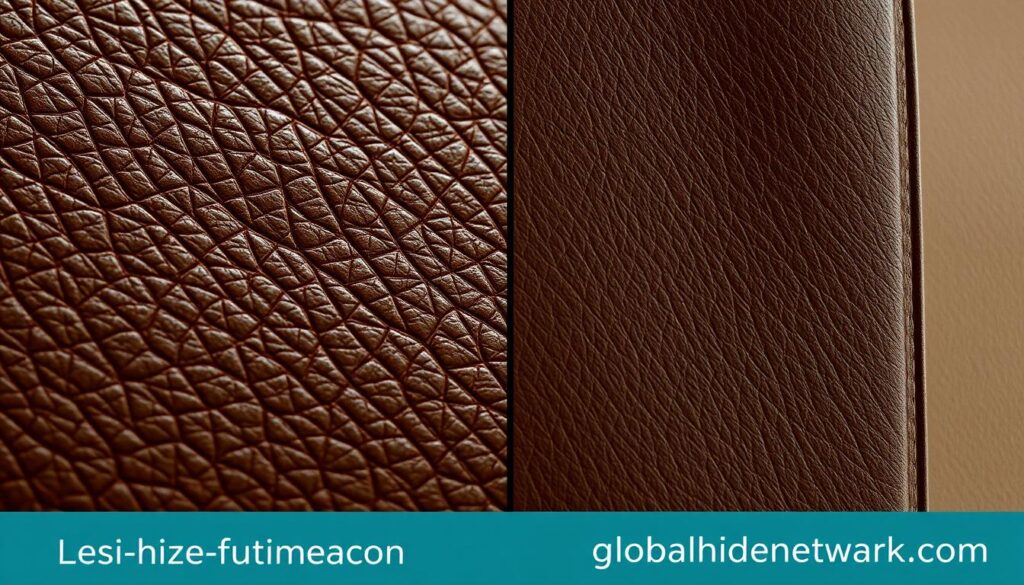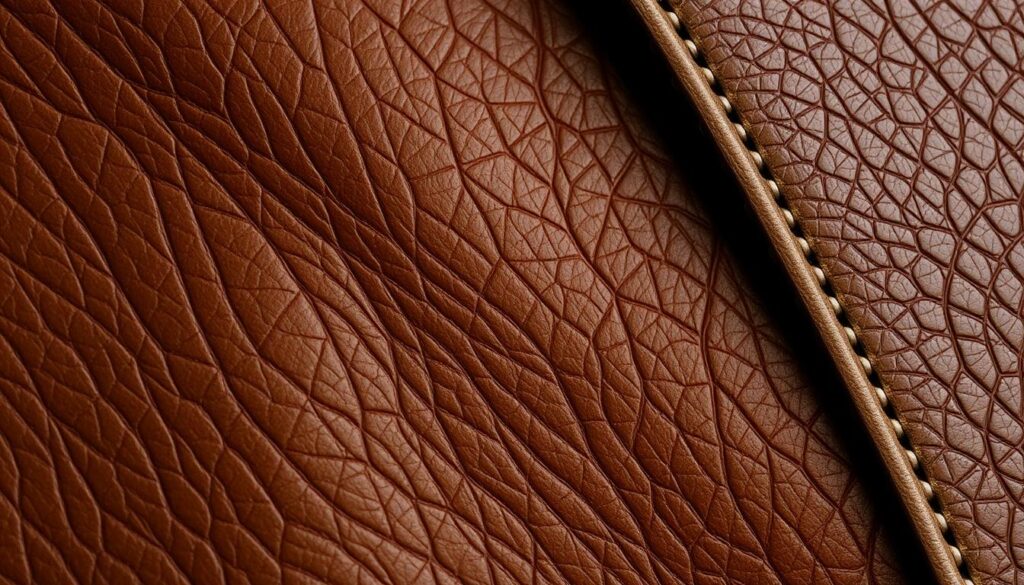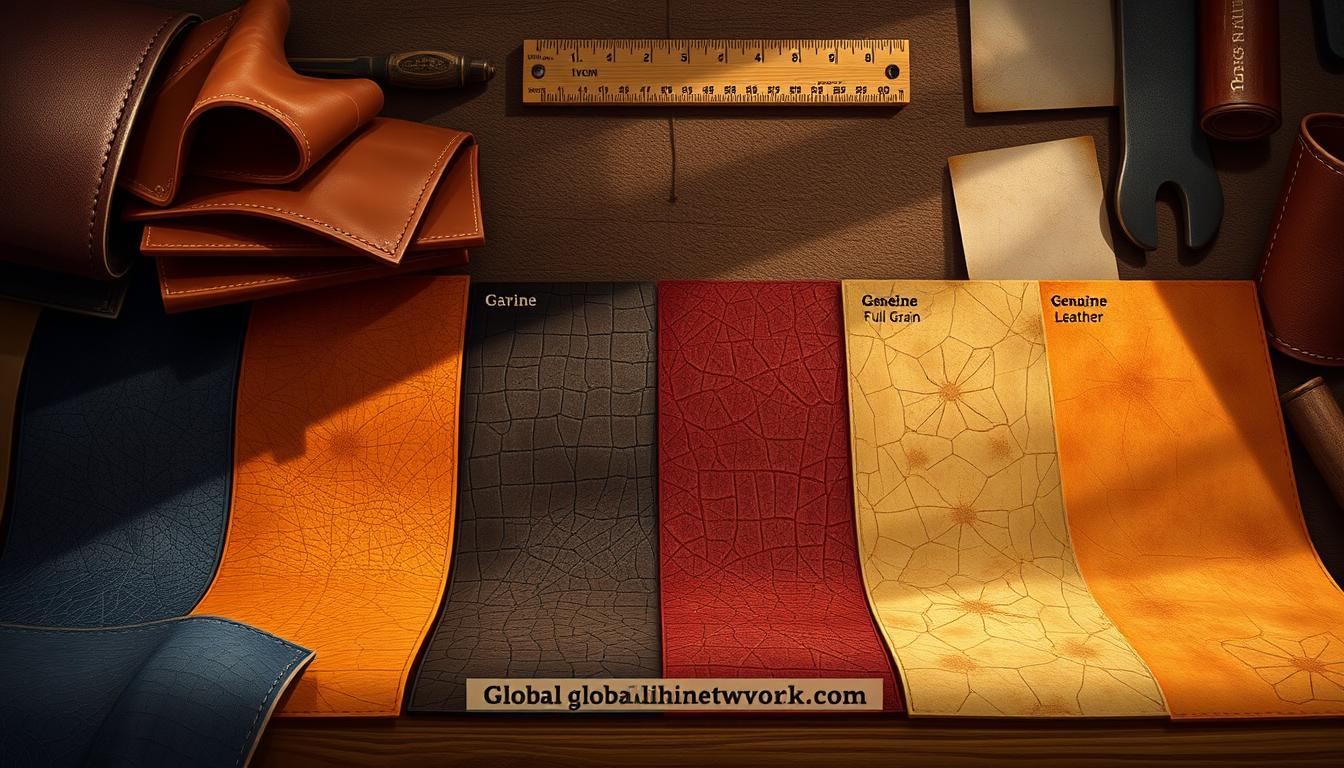Ever felt lost in the world of leather? I have. It’s hard to understand leather grades and quality. From full-grain to top-grain, the choices seem endless.
It’s frustrating when you can’t tell the difference between high-quality leather and cheaper alternatives. But don’t worry! I’ve got you covered. In this guide, I’ll break down leather types, grades, and quality markers.
You’ll learn to spot top-notch leather and make informed choices. Let’s dive into the rich, supple world of leather together!
Key Takeaways
- Full-grain leather is the highest quality, retaining natural markings
- Top-grain leather is the second-highest quality, sanded for uniformity
- Leather grades range from A (flawless) to F (factory rejected)
- Cowhide is commonly used for durability in furniture and accessories
- Exotic leathers, like alligator or ostrich, are used in high-end fashion
- Understanding leather types helps in making informed purchases
Introduction to Leather: A Timeless Material
Leather has fascinated people for centuries. Its versatility and lasting appeal are unmatched. It’s found in fashion and furniture, showing its importance in our lives.
The Significance of Leather in Fashion and Design
In fashion and design, leather stands out. Its natural beauty and strength make it a favorite among designers. Leather finishes can turn a simple outfit into something special.
From sleek jackets to stylish bags, leather adds luxury. It makes any look better.
| Leather Type | Price (per meter) | Quality |
|---|---|---|
| Full Grain | $80-$140 | Highest |
| Top Grain | $40-$79 | High |
| Genuine (Split) | $9-$39 | Medium |
| Bonded | $1-$39 | Low |
Historical Importance of Leather Across Cultures
Leather’s value has been seen across cultures and time. Ancient people used it for clothes, homes, and tools. Today, making leather is a complex process.
Different cultures have their own ways of caring for leather. This keeps its legacy alive for future generations.
Did you know most leather comes from cattle hides? This shows how important leather is worldwide. The way leather is made affects its quality and the environment.
Understanding Leather Grades and Quality
Leather grades are key to knowing the quality of leather products. The leather world sorts hides into five main types: full-grain, top-grain, split-grain, genuine leather, and bonded leather. Each type has its own special features and uses in fashion and design.
Full-grain leather is the top choice. It keeps the whole hide, including natural marks. It gets a beautiful patina over time, making it perfect for luxury items. Top-grain leather is close behind, with a smoother look from buffing and coloring.
Knowing about these grades is vital when looking at leather sourcing. Split-grain leather, used for suede, doesn’t have natural marks. Genuine leather, despite its name, is lower quality because it’s heavily processed. Bonded leather, the lowest, is not real leather but a mix of scraps and synthetic materials.
| Leather Grade | Characteristics | Common Uses |
|---|---|---|
| Full-grain | Natural markings, develops patina | Luxury goods, high-end accessories |
| Top-grain | Smooth appearance, durable | Upholstery, footwear |
| Split-grain | No natural markings | Suede products |
| Genuine leather | Heavily processed, lower quality | Mass-produced items |
| Bonded leather | Mix of scraps and synthetics | Budget furniture, accessories |
The making of leather greatly affects its quality. For example, Horween Leather Company’s Chromexcel goes through 89 steps over 28 days. This careful making makes the leather better.
Choosing the right leather grade depends on what you need and how much you want to spend. For lasting, quality items, go for full-grain or top-grain leather. They last long and get better with time. For cheaper options, genuine leather or bonded leather might work, but they won’t last as long.
The Leather Production Process
I’ve always been fascinated by the art of leather making. It turns raw animal hides into beautiful, durable materials we use every day. Let’s explore the three main stages: preparatory, tanning, and post-tanning.
Preparatory Stage: From Raw Hide to Workable Material
The journey starts with preserving raw hides. These are cleaned, de-haired, and split. This makes a workable material. It’s amazing how much work goes into prepping the hide before tanning.
Tanning Stage: Transforming Skin into Leather
This is where the magic happens. The tanning process can take up to eight hours in a rotating drum. There are different methods, each with unique results:
- Chrome tanning: Quick and cheap, but needs careful handling
- Vegetable tanning: Eco-friendly, produces firmer leather
- Combination tanning: Uses both methods for soft, supple leather
Post-Tanning Stage: Coloring and Finishing
After tanning, it’s time for Leather Finishes. This stage involves dyeing, conditioning, and applying protective coatings. The leather is dried, softened, and sometimes bleached. These final touches are crucial for creating high-quality leather products.
| Leather Type | Characteristics | Common Uses |
|---|---|---|
| Full Grain | Natural state, durable | High-end products |
| Top Grain | Uniform look, softer finish | Mid-range goods |
| Genuine | Sanded, dyed or painted | Cheaper leather items |
Understanding these processes helps in proper Leather Care. It ensures your leather goods last longer and look better. From raw hide to finished product, the leather production process is truly an art form.
Classification of Leather: From Top to Bottom
Exploring leather’s world, I find it full of variety. Let’s start from the best to the rest.
Full-Grain Leather is the top choice. It’s the whole hide, with natural marks. It gets a unique patina over time, sharing its own tale. It’s expensive but lasts a long time.
Then, there’s Top-Grain Leather. It’s Full-Grain’s smoother version. The surface is buffed for a sleek look. It’s less likely to stain, making it perfect for luxury items.

Genuine Leather might sound fancy, but it’s not. It’s made from lower-quality hide layers. It doesn’t have the natural grain and doesn’t age well.
Bonded Leather is at the bottom. It’s like particle board in the leather world. It’s made from scraps, dust, and synthetic stuff. It’s cheap but peels and cracks easily.
| Leather Type | Quality | Durability | Price |
|---|---|---|---|
| Full-Grain | Highest | Excellent | $$$$ |
| Top-Grain | High | Very Good | $$$ |
| Genuine | Medium | Fair | $$ |
| Bonded | Low | Poor | $ |
Knowing these grades helps me choose wisely. Whether I’m buying something expensive or something cheap, I know what I’m getting.
Common Tanning Methods and Their Impact on Leather Quality
Leather tanning turns raw hides into strong, flexible materials. I’ve looked into three main methods: vegetable, chrome, and oil tanning. Let’s explore how each affects leather quality.
Vegetable Tanning: Traditional and Eco-Friendly
Vegetable tanning uses natural tannins from trees. It’s eco-friendly and takes 30-60 days. The leather ages well, getting a nice patina over time.
It’s great for high-end items like saddles and fancy shoes.
Chrome Tanning: Efficiency and Flexibility
Chrome tanning uses chromium salts for soft, flexible leather. It’s fast, done in just one day. The leather is also colorfast and water-resistant.
Oil Tanning: Ancient Technique for Unique Properties
Oil tanning uses marine animal oils for lightweight, breathable leather. It has a special finish that gets better with use. This leather is perfect for outdoor gear and work boots.
| Tanning Method | Duration | Leather Characteristics | Common Uses |
|---|---|---|---|
| Vegetable | 30-60 days | Develops patina, durable | Luxury goods, saddlery |
| Chrome | 1 day | Soft, flexible, colorfast | Shoes, handbags, clothing |
| Oil | Varies | Lightweight, water-resistant | Outdoor gear, work boots |
Each tanning method changes leather’s durability and look. Knowing these differences helps pick the best leather for each use. This ensures the leather lasts long and works well.
Exploring Different Types of Leather
I’ve found that leather comes in many types, depending on its source and how it’s treated. Let’s explore some common kinds of leather.
Full-Grain Leather is the highest quality. It keeps the hide’s natural look, including scars. It costs between $80 to $140 per meter, showing its durability and unique look.
Top-Grain Leather is next in quality. It’s smoothed to remove scars, giving a shiny finish. It costs $40 to $79 per meter, making it a favorite for luxury items.
Genuine Leather, also known as Split Leather, is more affordable at $9 to $39 per meter. It’s made from the lower layers of the hide. It’s good for everyday items.
Bonded Leather is the cheapest, costing $1 to $39 per meter. It’s made from leftover leather pieces. It looks like leather but costs much less.
| Leather Type | Price Range (per meter) | Quality Level |
|---|---|---|
| Full-Grain Leather | $80 – $140 | Highest |
| Top-Grain Leather | $40 – $79 | High |
| Genuine Leather | $9 – $39 | Medium |
| Bonded Leather | $1 – $39 | Low |
Leather also depends on the animal it comes from. Cowhide is the most common, known for its strength. Lambskin is soft and light, great for fancy clothes. Goatskin is durable with a special grain, perfect for wallets and gloves. Pigskin is breathable, used in shoes and furniture.
Knowing about these differences is key when picking leather products. Whether you need a tough work boot or a soft leather jacket, understanding leather types helps you choose the best one.
The Grading System: From A to F
In my experience with leather, I’ve learned grading is key. The system goes from A to F. Each grade shows different levels of flaws.
A Grade: Flawless Perfection
A Grade leather is the best. It’s almost perfect, with only small flaws allowed. This top leather has a quality score of 95.1 to 100.
B to E Grades: Varying Degrees of Imperfections
As we go down, more flaws appear:
- B Grade: 5-10% imperfections
- C Grade: 10-20% imperfections
- D Grade: 20-30% imperfections
- E Grade: 30-40% imperfections
Each grade has its own quality score. This score affects its value and uses in leather products.
F Grade: Factory Rejected Leather
F Grade leather is rejected by factories. It has too many flaws. More than 50% of it can’t be used.
Knowing these grades is important for leather buyers and sellers. It ensures you get the quality you need.
Factors to Consider When Choosing Leather
When I look for leather goods, I think about a few important things. Leather durability is key. I choose full-grain and top-grain leathers for their lasting quality. These leathers can last for years and get even more beautiful with age.
Where the leather comes from is also important. I look for hides from places that treat animals well. Cowhides, which are 6-10mm thick, are split into top and bottom cuts for different uses.

The way leather is tanned affects its quality. For example, the Horween Chromexcel method takes 28 days and 89 steps. This makes the leather very durable and attractive.
It’s also important to take care of your leather. Different types need different care:
- Full-grain leather needs a little care but benefits from occasional conditioning
- Top-grain leather needs regular cleaning and moisturizing
- Split-grain leather (often called “genuine leather”) needs more care
- Bonded leather, while cheap, doesn’t last long and is hard to care for
By thinking about these things, I make smart choices when buying leather. Remember, good leather can last forever with the right care. It’s a great investment.
Care and Maintenance for Different Leather Grades
Proper leather care is key to keeping it looking good and lasting long. Each leather type needs its own care routine. Here are some important tips for taking care of your leather.
For full-grain and top-grain leathers, use a soft, damp cloth for cleaning. These leathers get better with age, showing off their unique look. Exotic leathers, like alligator or ostrich, need special care because of their special textures.
Leather finishes affect how you care for it. Aniline leather, the most natural and expensive, needs extra care to stay soft. Leather with protective finishes is easier to clean and less likely to stain.
| Leather Type | Care Frequency | Recommended Products |
|---|---|---|
| Full-grain | Every 6-12 months | Natural leather conditioner |
| Top-grain | Every 3-6 months | Leather cream |
| Genuine | Every 2-3 months | Leather protector spray |
| PU Leather | Monthly | Mild soap solution |
Regular conditioning helps prevent cracks and keeps leather strong. I condition every few months, depending on how much it’s used and the environment. Remember, a thin, even layer of conditioner is all you need.
By following these care tips, your leather items will stay beautiful and last a long time. This is true for any leather grade or finish.
Conclusion
I’ve shown you the world of leather, from its grades to its quality. Knowing about leather grades and quality helps you make better choices. You’ll find everything from expensive full-grain leather to cheaper bonded leather.
Let’s look at the leather quality ranking. Full grain is at the top, followed by top grain, split leather, and bonded leather. This order shows not just price, but also how durable the leather is. Full grain and top grain are great for luxury items like wine bags because they’re strong and stylish.
Don’t forget, how you care for leather affects its lifespan. Whether you spent a lot on full grain or saved with bonded leather, the right care keeps it looking good for years. Now, you can shop for leather with confidence, knowing all about its grades and quality.
